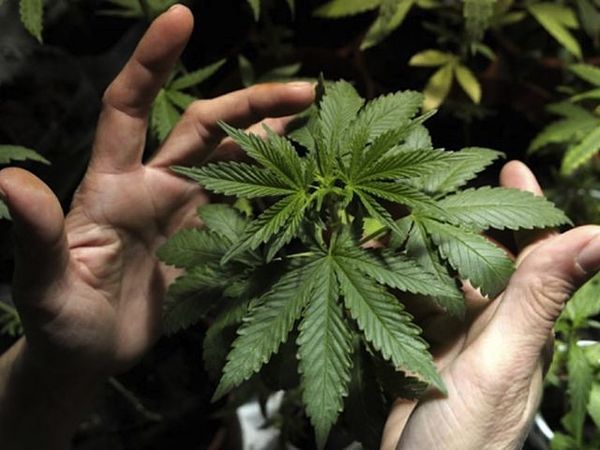- A good option to take advantage of the leftovers from your harvest this year is to invest them in producing cannabis-based medicines, like oils, pomades or teas.
- These are homemade remedies made with marijuana that can be put to a wide range of uses, and are devoid of side effects.
- Everything is thanks to the curative properties of the plant’s cannabinoids, which are easily processed by the human body.

Medicinal oil to ease pain and cheer you up
Cannabis's medicinal oil, made from a concentrate of marijuana resin, is highly effective for the treatment of all types of pains and inflammations, as it contains a high amount of CBD. This cannabinoid activates CB2 receivers in the body whose function is to regulate inflammations and block the pain we feel. It is, obviously, a product very rich in THC, the main cannabinoid and the plant's active, euphoria-inducing agent. When taken in the reduced doses corresponding to medicinal marijuana oil, it results in enhanced moods and well-being.
To prepare this cannabis oil it is advisable to use strains high in THC; Indicas, with a good percentage of CBD like the Critical Cheese seed or the Bubba Kush strains for those who prefer the reparative physical effects of medicinal marijuana in their oil; or Sativas, rich in THC, like Original Amnesia or Strawberry Haze,for those seeking the mood-lifting effects provided by the plant's main alkaloid.

Preparing marijuana oil is extremely easy and has dozens of medicinal benefits
What is it good for?
Medicinal oil from cannabis helps to assuage pain, has an anti-inflammatory effect, and reduces arterial tension, thanks largely to the sedative effects of the alkaloid known as CBD. It also lifts one's mood, stimulates the appetite, helps to regenerate the skin, reduces intraocular pressure, and lessens epileptic seizures, among many other benefits, thanks to the action of THC and the other cannabinoids the plant contains.
How to make it.
You will need to prepare a pure extract of marijuana resin by shaking some 20 buds and an abundant amount of leaves for ten minutes in a jar full of ethanol. This dissolves all the buds' resin in the liquid, which you should isolate from the plant matter using, for example, a paper coffee filter. Then leave the mixture of alcohol and resin to dry for five days or more, until you see that the alcohol has evaporated and only a blackish oil remains: the almost pure resin extract. With this method and amounts you will obtain a couple of grams of pure resin. Mix this with twenty times its weight in vegetal oil, stirring until the mixture is consistent.
Analgesic creams to alleviate muscle and joint damage
You can also take advantage of the remnants from your harvest to include an effective homemade cream to ease muscle pain and joint discomfort in your medicine kit. This ointment has a "burning" effect where placed that relaxes muscles and reduces cartilage discomfort. Its action is very effective on aching parts of the body, which absorbs its cannabinoids through the skin, these acting in a focused way on the area where the pomade is spread.
To produce it the ideal thing is to have planted strains high in CBD, like Critical Mass CBD or Shark Shock CBD, designed for this purpose. If these are not among your crops you can easily employ other varieties. There aren't many pains that will not be reduced by a pomade produced from a good OG Kush seed or a devastating Moby Dick.

A good pomade of grass always has a soft green colour and a creamy consistency
What is it good for?
To very effectively treat muscular pains, inflammations and rheumatic problems, thanks to its localized action. It is also very useful as a complementary treatment for burns and cuts, as it curbs pain, fends off infections, and favours the cutaneous regeneration process. Its use is recommended for a great number of common problems, such as boils and abscesses, dermatitis, cold sores…
How to make it.
Immerse about 20 expendable buds and plenty of leaves in hot water and stir for two to four hours (and not at very high temperatures, since the heat degrades the cannabinoids), in a solution with a litre of water and half a litre of oil. Then freeze the liquid you have obtained after by straining this concoction and set it aside to solidify, until the oil separates from the water. The cannabinoids will have adhered to this solidified oil. Boil in a pot with 50 grams of bee wax and let it sit until it takes on a homogenous and consistent texture.
Homemade pot soap to regenerate your skin
Soap made from cannabis is another one of those homemade products that you can make in an artisanal way to take advantage of the least attractive buds and leaves from our harvest. Not only is it an efficient tool to clean and disinfect the skin, but, thanks to its high vitamin E content, from the cannabis, it helps to fight free radicals and stimulates the regeneration of the skin. Its continued use assures one clean and smooth skin thanks to the grass's Omega 3 and 6 fats, which have a hydrating effect on the epidermis.

Marijuana soap is a practical remedy that can be used daily, enhancing your skin's health
What is it good for?
It is recommended for people with sensitive skins or cutaneous allergies because its properties prevent fungi and regulate skin PH. Thanks to its high vitamin E levels it is very effective at preventing dry or cracked skin, slight dandruff, hives and cutaneous rashes.
How to make it.
Heat up 5 kilos of cocoa butter in a vessel at 35º. At the same time, in another one, dissolve 670 grams of lye at the same temperature. Then mix them and stir for two hours. During this period add 670 g of oat flour to the mixture, 25 g of hemp flour, and 50 ml of marijuana oil. When this potion is consistent, pour into a mould and to let it sit for a whole day. Then uncover, let it dry for half a day, and cut it into small blocks that you will let "cure" for 3 or 4 weeks.
Dressings for cuts, wounds and burns
Marijuana poultices, hot bandages stuffed with grass, form part of an ancestral European pharmacological tradition. They were used centuries ago to treat burns, rashes and to palliate very severe cutaneous pain, such as that caused by the boils of the Black Plague. They ceased to be used during the Middle Ages because the Inquisition believed cannabis to be "Satanic" in nature. It is an almost forgotten solution that is very effective against cutaneous problems thanks to the sedative properties of cannabis and its regenerative effects on the epidermis. To produce it the use of Indica and Rudelaris substrains is best. Rich in CBD, they have sedative effects and block pain; it is ideal if your garden has some auto-flowering Blue Cheese seeds or auto-flowering White Widows.

Cannabis poultices are a traditional remedy, lost due to political questions
What are they good for?
It is a highly effective treatment against cutaneous injuries because the skin absorbs the marijuana's cannabinoids very quickly, which are able to enter the body's cells quickly, yielding a reparative action. The sedative potential of marijuana eases pain from wounds, while other components, such as vitamin E, favour the regeneration of the epidermis.
How to make it.
To make them place a few buds and all the leaves you can squeeze into some very hot and damp cotton gauzes or cloths. The plant matter must be on the back of the dressing, which we will be applied to the area you want to treat.
Root tea, to treat the body from within
Recent studies have demonstrated that marijuana roots also contain cannabinoids, especially CBD, which makes them yet another part of the plant apt for medicinal applications. It has been used in Chinese medicine for almost 4,000 years; since the systematic architect of traditional medicine there, Emperor Shen Nung, included its use in his famous medicine book Pent Sao, one of the oldest medical documents in history.
 The medicinal properties of roots have yet to be fully discovered in the West.
The medicinal properties of roots have yet to be fully discovered in the West.
What is it good for?
Chinese medicine has been using it for more than 4,000 years as a diuretic, to treat asthma, respiratory obstructions, internal haemorrhages, menstrual pain, and to alleviate the pain from surgery on internal organs.
How to make it.
To prepare a root tea you will need to clean the roots very well, cut them, and grind them until they take on a powdery consistency. Then let them fully dry. Boil a small portion of the remaining powder - similar to that for a normal tea - in a litre of water. Teas cannot be made with roots from plants that have been treated with chemical fertilisers or nutrients, as these substances can adversely affect the body. And their use should also be occasional, to treat specific ailments; excessive intake - for example, if taken every day - can be damaging to the blood.



Comments from our readers
There are no comments yet. Would you like to be the first?
Leave a comment!Did you like this post?
Your opinion about our seeds is very important to us and can help other users a lot (your email address won't be made public).